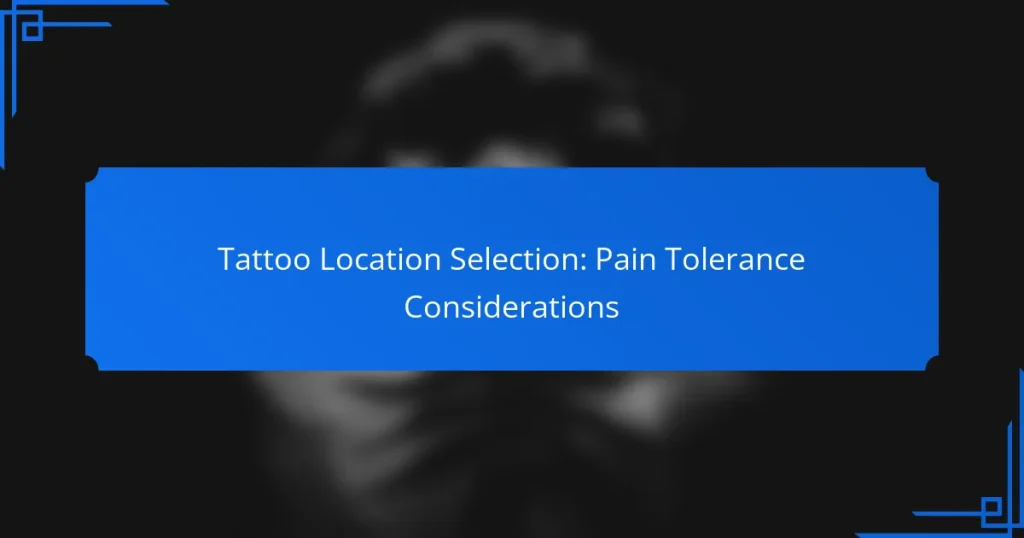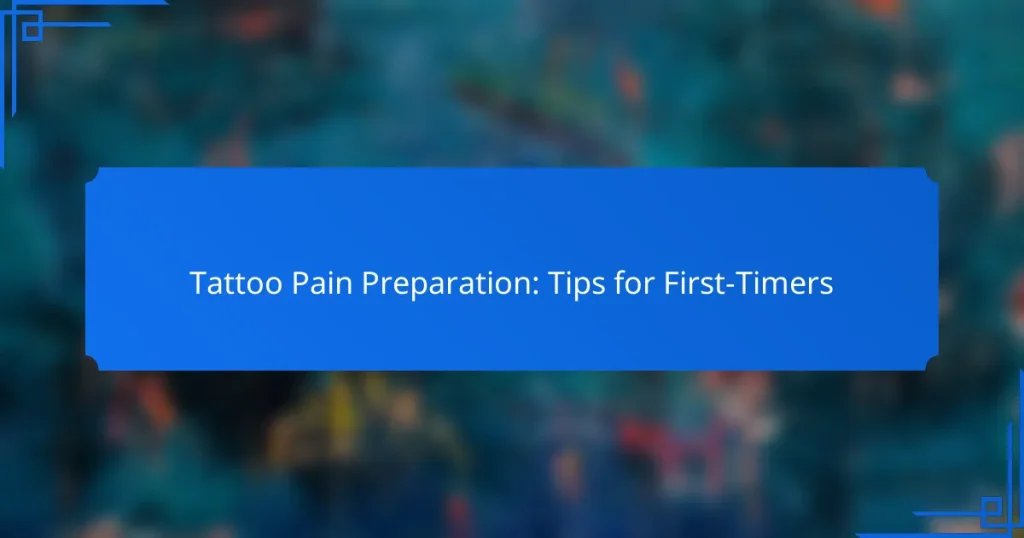Tattoo pain levels can differ greatly depending on various factors such as the tattoo’s location, the individual’s skin sensitivity, and the size of the design. By understanding these pain levels, individuals can better prepare for their tattoo experience and make informed decisions about placement. Additionally, employing pain management techniques can help minimize discomfort during the process.
Tattoo Pain Expectations: What Beginners Should Know
Tattoo Pain Areas: Body Parts That Hurt More
Tattoo Pain Management: Techniques for Beginners
Tattoo Pain Levels: Factors, Expectations and Management
Tattoo Location Selection: Pain Tolerance Considerations
Tattoo Pain Preparation: Tips for First-Timers
What Are the Main Tattoo Pain Levels?
Tattoo pain levels vary significantly based on the location of the tattoo on the body. Understanding these pain levels can help individuals prepare for their tattoo experience and choose placement wisely.
Low pain areas
Low pain areas are typically found on fleshy parts of the body where there is more muscle and fat cushioning the skin. Common locations include the upper arm, thigh, and outer shoulder. These areas often result in a mild, manageable sensation during the tattooing process.
For those concerned about pain, choosing a tattoo placement in these regions can make the experience more comfortable. Many first-time tattoo recipients prefer these locations to ease into the process.
Moderate pain areas
Moderate pain areas include regions with less flesh and more nerve endings, such as the forearm, calf, and side of the torso. The pain here can be described as a sharper sensation, but it is still generally tolerable for most individuals.
When selecting a tattoo spot in these areas, be prepared for a bit more discomfort. However, many people find the pain manageable and worth it for the final result.
High pain areas
High pain areas are characterized by thin skin, proximity to bone, or dense nerve endings. Common examples include the spine, ribs, and inner bicep. The pain in these areas can be intense and may cause some individuals to flinch or feel anxious during the process.
If you are considering a tattoo in a high pain area, it’s advisable to mentally prepare yourself for a more challenging experience. Discussing pain management options with your tattoo artist can also be beneficial.
Extreme pain areas
Extreme pain areas are often the most sensitive parts of the body, such as the armpits, neck, and hands. Tattoos in these locations can be excruciating due to the high concentration of nerve endings and minimal flesh. Many people find these areas to be the most difficult to endure.
If you are contemplating a tattoo in an extreme pain area, it’s crucial to weigh the significance of the design against the potential discomfort. Consider starting with a less sensitive area to build your tolerance before moving to more painful spots.
How to Manage Tattoo Pain?
Managing tattoo pain involves a combination of techniques that can help reduce discomfort during the tattooing process. Effective methods include using numbing creams, pain relief medications, and distraction techniques to make the experience more tolerable.
Numbing creams
Numbing creams are topical anesthetics that can significantly reduce pain during tattoo sessions. They typically contain ingredients like lidocaine or benzocaine, which block nerve signals in the skin. Apply the cream about 30 minutes to an hour before your appointment for optimal effectiveness.
When using numbing creams, follow the instructions carefully to avoid skin irritation or allergic reactions. It’s advisable to consult with your tattoo artist beforehand, as some may have preferences regarding their use.
Pain relief medications
Pain relief medications, such as ibuprofen or acetaminophen, can help manage discomfort before and after getting a tattoo. Taking these medications as directed can provide relief from pain and inflammation. However, avoid taking aspirin, as it may increase bleeding during the procedure.
Consult with a healthcare professional if you have any underlying health conditions or are taking other medications, as interactions may occur. Timing is also crucial; take the medication about an hour before your tattoo session for the best results.
Distraction techniques
Distraction techniques can effectively help manage tattoo pain by shifting your focus away from the sensation. Listening to music, engaging in conversation, or using stress balls can divert your attention during the tattooing process.
Consider bringing headphones to listen to your favorite playlist or a podcast. Some people find that deep breathing exercises or visualization techniques can also help reduce anxiety and pain perception during the tattoo session.
What Factors Affect Tattoo Pain Levels?
Tattoo pain levels can vary significantly based on several factors, including individual skin sensitivity, the location of the tattoo on the body, the type of needle used, and the size of the tattoo. Understanding these factors can help you prepare for the experience and manage expectations.
Skin sensitivity
Individual skin sensitivity plays a crucial role in how much pain a person feels during a tattoo session. Some people have more sensitive skin, which can lead to heightened discomfort. If you know you have sensitive skin, consider discussing this with your tattoo artist beforehand.
To gauge your sensitivity, you might want to test a small area with a temporary tattoo or a similar procedure. This can give you an idea of how your skin reacts and help you prepare for the actual tattoo.
Tattoo location
The location of the tattoo significantly influences pain levels. Areas with more muscle and fat, such as the upper arm or thigh, typically experience less pain compared to bony or sensitive areas like the ribs, spine, or hands. Understanding the anatomy of your chosen location can help you anticipate discomfort.
Consider discussing the location with your tattoo artist, as they can provide insights on pain expectations based on their experience with similar placements.
Needle type
The type of needle used in the tattooing process can affect pain levels. Different needles have varying configurations, such as single needles for fine lines or multiple needles for shading. Generally, single needles may cause less discomfort than larger groupings, but this can vary based on individual tolerance.
When selecting a needle type, consult with your tattoo artist about the best option for your design and pain threshold. They can recommend the most suitable needle configuration to minimize discomfort while achieving the desired effect.
Tattoo size
The size of the tattoo also impacts pain levels. Larger tattoos often require longer sessions, which can lead to increased discomfort over time. Smaller tattoos may be less painful due to their quicker application, but the pain can still vary based on the other factors mentioned.
If you’re concerned about pain, consider starting with a smaller tattoo to build your tolerance. This approach allows you to gauge your pain threshold and make informed decisions for future, larger pieces.
How Do Pain Levels Vary by Tattoo Style?
Pain levels during tattooing can significantly differ based on the tattoo style chosen. Factors such as needle depth, design complexity, and the area of the body being tattooed all contribute to the overall discomfort experienced.
Traditional tattoo pain
Traditional tattoos often involve bold lines and solid colors, which can lead to moderate pain levels. The use of thicker needles and deeper penetration into the skin typically results in a more intense sensation, especially in sensitive areas like the ribs or inner arms.
For those considering a traditional tattoo, it’s advisable to prepare for a pain level that can range from moderate to high, depending on the specific location on the body. Taking breaks during the session can help manage discomfort.
Realistic tattoo pain
Realistic tattoos require intricate shading and detail, which can cause varying pain levels. The need for multiple passes over the same area may increase discomfort, particularly in sensitive spots.
Individuals opting for realistic tattoos should expect a pain range from moderate to high, especially if the design covers a large area. Communicating with the artist about pain management techniques can enhance the experience.
Watercolor tattoo pain
Watercolor tattoos are known for their soft, flowing designs and vibrant colors, which can lead to a unique pain experience. The technique often involves lighter needle pressure, resulting in lower pain levels compared to traditional styles.
While watercolor tattoos generally cause less discomfort, pain can still vary based on the tattoo’s placement. Areas with more flesh, like the upper arm, may feel less painful than bony areas, such as the wrists or ankles.
What Are Common Myths About Tattoo Pain?
Understanding the common myths about tattoo pain can help potential clients prepare for their tattoo experience. Many misconceptions can lead to unnecessary anxiety or misinformed expectations.
Myth: Tattoos are always painful
While tattoos do involve some level of discomfort, the pain is not uniform across all areas of the body. Factors such as the location of the tattoo, the size, and the individual’s pain tolerance play significant roles in the overall experience.
For instance, areas with more flesh and muscle, like the upper arm or thigh, tend to be less painful compared to bony areas like the ribs or ankles. Many people describe the sensation as more of a scratching or vibrating feeling rather than intense pain.
Myth: Pain is the same for everyone
Each person’s experience with tattoo pain can vary significantly based on their individual pain threshold and mental state. Factors such as anxiety levels, previous experiences with pain, and even the artist’s technique can influence how one perceives the pain during the tattooing process.
Additionally, cultural background and personal beliefs about pain can shape how someone reacts to the sensation. It’s essential for individuals to communicate their concerns with their tattoo artist to ensure a comfortable experience tailored to their needs.
How to Choose a Tattoo Artist Based on Pain Management?
Choosing a tattoo artist who prioritizes pain management can significantly enhance your tattoo experience. Look for artists who are knowledgeable about pain relief techniques and have a reputation for making the process as comfortable as possible.
Experience with pain management
When assessing a tattoo artist’s experience with pain management, consider their training and background. Artists who have undergone specialized training in pain relief techniques, such as using numbing creams or understanding pain thresholds, are often better equipped to help clients manage discomfort.
Ask potential artists about their methods for minimizing pain during the tattooing process. Some may use topical anesthetics, while others might incorporate techniques like distraction or breathing exercises. A skilled artist will be able to explain their approach and adapt it to your needs.
Additionally, look for reviews or testimonials from previous clients regarding their pain management experiences. Positive feedback can indicate that the artist is effective in creating a more comfortable environment for getting tattooed.






